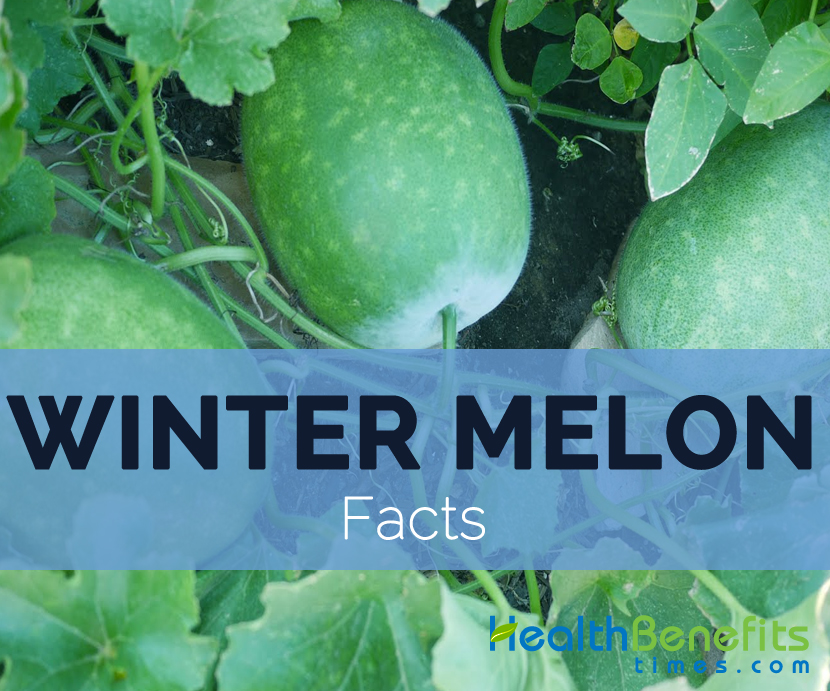
| Name | Winter melon |
|---|---|
| Scientific Name | Benincasa hispida |
| Native | South Asia and Southeast Asia, now is widely cultivated throughout Asia, the Americas, Europe and Australia. During the Renaissance, Winter melon was introduced to Europe. |
| Common/English Name | Wax Gourd, Ash Gourd, Chinese Water Melon, Chinese Preserving Melon, Joined Gourd, Gourd Melon, Tallow Gourd, Winter Melon, Winter Gourd, White Pumpkin |
| Name in Other Languages | Burmese: Kyauk-Hpayon, Kyauk Pha-Yon Thee; Czech: Tykev Vvosková; Chinese: Pai Gua, Dong Gua; Danish: Voksgræskar, Voksagurk; Dutch: Waskalebas; Eastonian: Vahakõrvits; French: Pastèque De Chine, Courge Cireuse; German: Wintermelone, Prügelkürbis; India:- Assamese: Komora, Kumora, Bengali: Kumra, Chal Kumra, Hindu: Gol-Kaddu, Raksa, Kannada: Boodu Gumbala, Kooshmaanda, Malayalam: Cumbulam, Kumpalam, Marathi: Kohala, Mizoram: Maipawl, Sanskrit: Brhatphala, Kushmanda, Tamil: Alattuppucini, Ven Poosani, Tulu: Karkumbuda, Telugu: Budidegummadi, Pendligummadikaaya, Urdu: Petha; Indonesia:– Aceh: Kundur, Kundo, Bugis: Kunrulu, Dayak: Butong, Gayo: Gundur, Irian Jaya: Laha, Javanese: Baligo, Bligo Semangka, Lampung: Sardak, Madurese: Kundur, Bhaligho, Malay: Beligu, Kundur, Minangkabau: Kundue, Nias: Undru, Simalur: Kudul, Sundanese: Baligo, Leyo; Italian: Zucca Della Cera; Japanese: Togan, Togwa; Khmer: Trâllach; Korean: Dong A; Laotian: Tônx, Mak Ton; Malaysia:– Malay: Kundur, Kundor, Iban: Ensengai, Celau; Nepalese: Petha, Kubiindo; Pakistan: Petha; Philippines:- Bikol: Rodal, Bisaya: Tibiayon, Kandol, Iloko: Tabungaw, Ivatan: Kondol, Kapampangan: Kundul, Subanum: Tabugok, Sulu: Kundal, Tagalog: Tambulok, Kondol; Portuguese: Abóbora D’água, Comalenge; Singapore (Hokien): Tang Kua; Spanish: Calabaza China, Calabaza Blanca; Sri Lanka (Sinhalese): Puhul; Taiwanese: Dangguev; Thai: Faeng, Fak, Mafak Mon; Tibetan: Ku-Sma-Nda-Ka; Turkish: Mom Kabagi; Vietanamese: Bí Dao, Bi Xanh. |
| Plant Growth Habit | Annual, hispid, robust, monoecious climbing |
| Growing Climate | Warm tropical and subtropical |
| Soil | Well-drained, light, friable |
| Plant Size | 1-2 m. (3-6 ft.) |
| Lifespan | Long shelf life |
| Stem | Terete, thick, furrowed and coarsely hairy |
| Leaf | Rounded or kidney-shaped, Diameter: 10 – 25 centimeters, 5-7 lobed, heart-shaped at base |
| Edible parts of the plants | Fruit: It is consumed as vegetables. The raw ones are consumed like sliced cucumbers. It is also consumed as fruit drink which have distinctive taste. Pulp: The pulp could be preserved in the form of sweet candies and pickles. Shoots, tendrils and leaves: It is fried, boiled or cooked and consumed as greens. Flower buds: It is used in sayur or in the form of sepan. Seeds: Seeds are eaten by roasting or frying as snack foods. |
| Flowering Season | July – September |
| Flower | Large, yellow, hairy bell-shaped calyx tube |
| Fruit shape & size | Ovoid or ellipsoid, length: 25 – 40 cm |
| Fruit weight | 30 pounds |
| Fruit color | Green with chalky white wax |
| Flesh color | White |
| Fruit peel | Thin |
| Flavor/aroma | Mild aroma, not prominent |
| Fruit Taste | Sweet |
| Seed | Flat, ovate – elliptic, ridged and yellowish brown |
| Varieties/Types |
|
| Fruit Season | Cold |
| Major Nutritions | Total dietary Fiber 3.8 g 10.00% Sodium, Na 147 mg 9.80% Zinc, Zn 0.81 mg 7.36% Iron, Fe 0.53 mg 6.63% Vitamin B1 (Thiamin) 0.053 mg 4.42% Phosphorus, P 25 mg 3.57% Vitamin B6 (Pyridoxine) 0.046 mg 3.54% Vitamin B5 (Pantothenic acid) 0.176 mg 3.52% Manganese, Mn 0.077 mg 3.35% Copper, Cu 0.03 mg 3.33% Vitamin B3 (Niacin) 0.528 mg 3.30% Magnesium, Mg 13 mg 3.10% Carbohydrate 3.96 g 3.05% Calcium, Ca 25 mg 2.50% Vitamin B9 (Folate, Folic acid) 7 µg 1.75% |
| Health Benefits |
|
| Calories in 1cup (132 gm) | 17 Kcal. |
| Traditional uses |
|
| Precautions |
|
| How to Eat |
|
| Other Facts |
|
Comments
comments